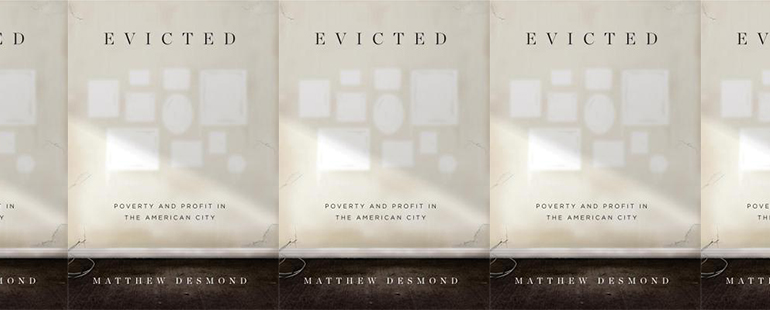The Value of the Third-Person Perspective in Evicted

In nonfiction, there seems to be a recent trend to use first-person narration even when the topic at hand is not personal in nature. This point of view has its benefits, of course—among them congeniality and intimacy—but there are still times when the third-person perspective may be a more fitting approach. 2016’s Evicted: Poverty and Profit in the American City, by Matthew Desmond, chronicles the experience of eight Milwaukee families as they strive to achieve stable housing and employs a strict, third-person narration in the main body of the book. This decision is striking: it leaves out elements like project scope, goals, or methodology, as well as authorial information or impressions, which have become almost standard in books of this kind. In place of such details, Evicted foregrounds its families, using the third-person’s intimate and panoramic lens to elevate their often-harrowing stories and to reveal the trauma of housing instability at every level.
Arleen and her two sons Jori and Jafaris form one of Evicted’s eight central families, and as Evicted begins they have received a notice from their landlord to vacate their apartment. It is January in a record-breaking, frigid Minnesota winter when the movers arrive, and Arleen does not have the $350 needed to pay for storage services. She can only watch as “her mattresses. A floor-model television. Her copy of Don’t Be Afraid to Discipline. Her nice glass dining table and the lace tablecloth that fit just so” are put on the street. Having lost her home and possessions, Arleen must then take her children to the homeless shelter, “which everyone called the Lodge so you could tell your kids, ‘We’re staying at the Lodge tonight,’ like it was a motel.” From this first scene, readers are thrust directly into Arleen’s point of view and invited to share her loss and her desire to shield her children in dire circumstances. The third-person narration centers on her perspective, giving no doubt that her experience is the one that matters. In Evicted, each family is shown in such a way, without the need to justify why they are being seen. They are simply people worth knowing on their terms rather than because they are part of a project.
While families like Arleen’s bear the burden of eviction at a personal level, their struggles are connected to entrenched and widespread housing practices that Evicted also explores in detail. From Arleen’s eviction, the book pans out to consider how “even in the most desolate areas of American cities, evictions used to be rare . . . These days, there are sheriff squads whose full-time job is to carry out eviction and foreclosure orders. There are moving companies specializing in evictions, their crews working all day, every weekday.” Eviction is not a result of bad luck or planning, it is “a main feature of landed capital, a prime moneymaker for those who [see] ripe opportunity in land scarcity, housing dilapidation, and racial segregation.” Such information may be startling to those unused to considering housing instability as a business, but there can be no understanding Arleen’s tenuous housing situation without also seeing the landscape on which it rests. Evicted moves nimbly between the individual and the contextual, aided in part by the third-person perspective’s easy omniscience, and it uses this interplay to expose the connections that drive housing instability—and that cause Arleen’s things to be put on the curb while she takes her children to a homeless shelter.
An eviction may seem like the end of the story as far as housing is concerned, but it is in fact only one stop in a cycle. After losing housing, a family may end up at a shelter like The Lodge, homeless, or in another housing situation. Another of Evicted’s families, Crystal and Vanetta, meet while staying at the Lodge, and after they and their children become friends, they decide to look for housing together. Their budget is $550 a month for a two-bedroom, and Vanetta especially wants “a tub so her kids could take baths.” In their search, they try “for seventy-three places, [before being] approved for a $500-a-month two-bedroom apartment. In the apartment, the “wood floors were sticky with grime . . . the sink was clogged . . . there were empty spaces where a stove and refrigerator had once been.” Despite its grimness, Crystal and Vanetta take some comfort in the fact that it does have a tub. Their situation is one of immediate despair, but the narration remains relatively descriptive and impersonal, which becomes a strength in that it captures Crystal and Vanetta’s reality with greater accuracy. They may wish for better—who wouldn’t?—but apartments like this are their norm, an inevitable result of “desperate tenants willing to overlook neglected repairs [upon finding] a desperate landlord willing to overlook evictions and convictions.” For the narrator to comment, to react, would be disingenuous. The story’s matter-of-factness echoes that for Crystal and Vanetta, these are the facts of life.
Many renters know that while landlords have some discretion over who to rent to—prohibiting pets and smoking on their properties, for example—there are laws in place that make housing discrimination illegal. Such laws are intended to help, but Crystal and Vanetta’s search is made all the more difficult by rental companies who reject applicants for “any evictions within the last 3 years . . . felony drug or violent crime conviction within the last 7 years . . . non-verifiable income or insufficient income.” Such practices result in part from landlords seeking to “avoid discriminating by setting clear criteria and holding all applicants to the same standards.” While perhaps sound in theory, these policies are damning in reality: “equal treatment in an unequal society [can] still foster inequality. Because black men [are] disproportionately incarcerated and black women disproportionately evicted,” they are still less likely to be able to find and maintain stable housing. This is valuable context once again in the full picture of housing instability. Even policies meant to help don’t, and the broad third-person perspective of Evicted helps to show these problems as they are—problems beyond any one person or writer.
When it comes to housing, landlords function as a middleman between persons and systems and Evicted also features a landlord named Sherrena who owns dozens of properties in the poorer sections of Milwaukee. She interacts with many of the book’s families and vacillates between spending her own money to buy groceries for tenants like Arleen and evicting them for calling the police during domestic violence incidents. In one extreme case, when a fire breaks out at one of her properties and kills the tenant’s baby, Sherrena responds by asking the fire inspector “if she was obligated to return Kamala’s and Lamar’s rent . . . ‘They are not getting any money back from me,’ she said . . . ‘The only positive thing I can say is happening out of all this is that I may get a huge chunk of money.’” The brutality of this attitude is staggering, and there seems to be nothing a narrator could say that would add anything to the scene. In fact, the presence of an outside narrator would only detract; they would inevitably siphon attention from the families and would also serve as a reminder of a world outside this family’s, one in which such cruelty is less unusual. An on-scene narrator would be an escape for the reader, and Evicted rightly does not offer this buffer. Readers instead are made to stay in the family’s world, to know it not through an intermediary but as their own.
It may seem that there should be consequences for a fire that kills a baby—especially when there are questions around whether fire alarms in the apartment were properly installed—but once again, systems fail. The fire inspector tells Sherrena she “‘didn’t have anything to worry about.’ She wasn’t liable for anything that had happened.” Sherrena goes on to bulldoze the burned building and “[uses] the insurance money to buy two new duplexes, doubling the units she had lost in the fire . . . The only remaining visible reminder of that night was a makeshift memorial Kamala and her family set up.” In this case, the third-person narrator builds the sense that these families have no recourse when it comes to the systems stacked against them. It is an impression both despairing and truthful, and Evicted makes it clear that nationwide, these are circumstances that families face every day. The range of perspectives presented within is necessary to show what housing instability means, both to those who suffer from it and for those who profit from it.
Though Evicted makes it clear that the housing crisis in the United States has proliferated for many years, evictions have come to greater prominence in recent weeks due to COVID-19’s exacerbation of the crisis and as part of a growing recognition of widespread, racist practices. Such attention is gratifying and long overdue, and in this context, Evicted offers an important example of how writing can speak on complex social problems while being respectful of the subject matter and never losing sight of what matters. As more work is produced that seeks to bear witness and amplify marginalized voices, it may be important to keep in mind that there are many ways and points of view when telling stories. It’s even true that sometimes the best thing a writer can do is to step back and let the story speak for itself.



